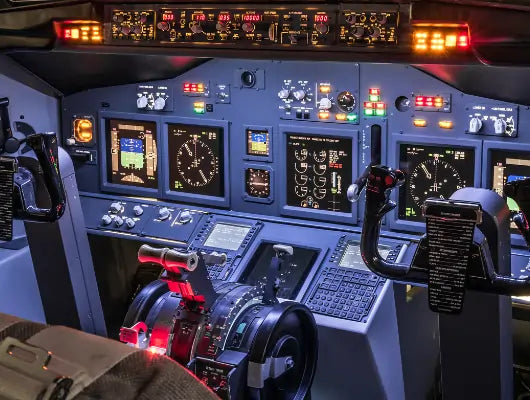
Virtual Reality In-Flight Simulation: Taking Immersion To New Heights
Share
VR technology is soaring to new heights in flight simulation, offering a new level of realism and immersion for pilots and aviation enthusiasts. They can now fully immerse people in virtual cockpits using VR headsets and motion platforms, making it difficult to differentiate them from real-life situations. VR technology has revolutionized the world of flight simulation in the following ways.
At FlightSimBuilder, you will find a range of products, such as flight simulator controls and accessories, to meet all your flight simulation needs.
How Virtual Reality In-Flight Simulation Has Advanced Significantly
Virtual reality has taken the flight simulation space by storm with:
- Incomparable Visual Immersion—These VR devices give pilots a feeling of being inside the cockpit by providing 360-degree visuals. The displays have high resolutions, while their fields of view are broad, creating depth and realism that flat screens cannot achieve. Consequently, users can move their heads around the virtual cockpits, check instruments, and survey environmental surroundings closer, which improves training.
- Spatial Awareness and Situational Awareness - VR is good at developing spatial and situational awareness regarding flight simulation. Virtual reality headsets detect movements made by the user's head so they can quickly look inside and outside their plane's cockpit. This heightened sense of awareness is crucial for pilots, as it enables them to understand better their position relative to other aircraft, terrains, or obstacles, thereby improving decision-making and risk assessment skills.
- Realistic Motion Simulation—When combined with motion platforms, VR flight simulators can recreate the physical sensations of flight, such as acceleration, turbulence, and changes in altitude and attitude. This multisensory experience further enhances immersion and realism, thus helping build crucial muscle memory, which is essential during actual flying activities.
- Procedural Training and Muscle Memory—Pilots may benefit from using VR simulators since they provide complex procedure training while also building muscle memory. Interacting with virtual controls or instruments realistically allows pilots to practice repeating tasks or scenarios until they become second nature. This will enable a faster reaction time if something goes wrong during an actual flight, thus avoiding danger.
- Cost-Effective and Accessible Training—VR is increasingly becoming more affordable and accessible to a broader audience compared to expensive commercial flight simulators. Virtual reality headsets aimed at consumers and their software can be used for simulation purposes at a much lesser cost than traditional simulators, making more people able to engage in flight training. Yet, they have the ambition of being pilots.
- Customizable and Scalable Environments—VR flight simulators offer unmatched customization and scalability. Instructors can create or modify virtual environments, planes, scenarios, etc., to suit their training objectives. VR also allows for various types of airplanes, from small general aviation craft to large commercial airlines, thus providing a versatile platform for training pilots.
As VR technology continues to gain sophistication, there is tremendous potential for integrating it into flight simulation. With VR now making a genuinely immersive and real-life-like experience possible, it could reinvent pilot training by improving safety, efficiency, and readiness against challenges posed by everyday flights.
If you are getting started with pilot training and need more information about the G1000 simulator and our other options, please message FlightSimBuilder via this Contact Us page.
